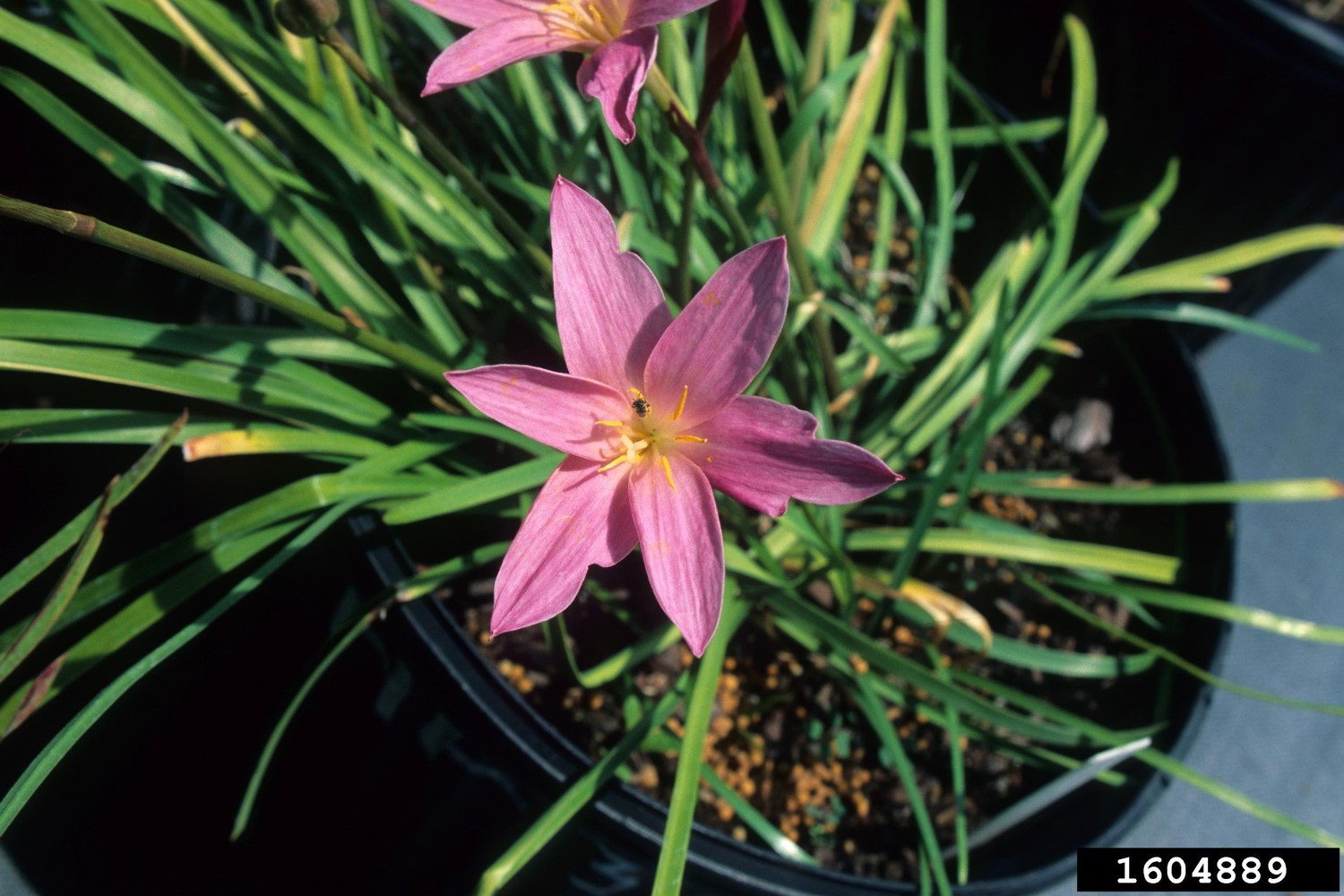
by Mary Salinas | Sep 2, 2016
Florida is home to many gorgeous and desirable native plant species. One to consider for your landscape is the rainlily, Zephyranthes and Habranthus spp. They are easy to care for and are bothered by few pests.
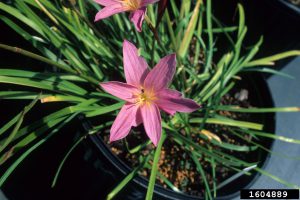
Cuban rainlily, Zephyranthes rosea. Photo: John Ruter, University of Georgia, Bugwood.org
As the name implies, rainlilies do thrive when getting consistent rain or watering. A good soaking rain event will result in blooms within a few days. This love for moisture makes them perfect for rain gardens.
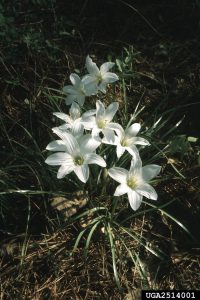
Atamasco rainlily, Zephyranthes atamasco. Photo: Jerry A. Payne, USDA Agricultural Research Service, Bugwood.org.
Plant the bulbs or transplants in full sun to part shade in moist but well-drained fertile soil. Let them be for many years in order to form large impressive clumps and that is when they flower the best. You can also separate the clumps every few years to colonize new areas and pass along to others. After the plants bloom they will reliably set seed that you can collect to start rainlilies in other parts of your garden. However, the seeds are viable for only a short time so you should plant them immediately.
For sources of plant material, try your local nursery that tends to carry native plants or through online sources.
For more information:
Rainlily, Zephyranthes and Habranthus spp.: Low Maintenance Flowering Bulbs for Florida Gardens
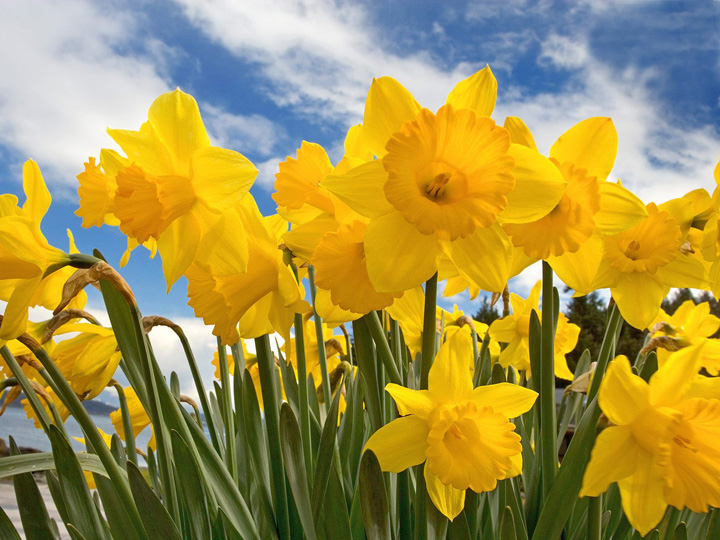
by Sheila Dunning | Feb 25, 2016
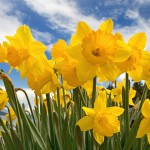 Few plants seem to signify the freshness of spring quite as well as daffodils. The name “daffodil” is derived from “addodell” a variant of Asphodel (a plant of the Asphodelus genus.) In historical documents and the common language of 16th century Europe, the term “daffodil” referred specifically to the wild daffodil, Narcissus pseudonarcissus.
Few plants seem to signify the freshness of spring quite as well as daffodils. The name “daffodil” is derived from “addodell” a variant of Asphodel (a plant of the Asphodelus genus.) In historical documents and the common language of 16th century Europe, the term “daffodil” referred specifically to the wild daffodil, Narcissus pseudonarcissus.
The derivation of the Latin narcissus is unknown. It is frequently linked to the Greek myth of Narcissus, who was rumored to be so obsessed with his own reflection that he died while gazing at himself in a pool of water. From the location of his death sprang the narcissus plant. Another Greek myth finds Persephone, daughter of the goddess Demeter, lured to her doom by the God Hades while picking a narcissus. Therefore the plant is perceived as a symbol of vanity in some Western culture.
Others attribute the plants’ name to its narcotic properties. One translation of the Greek name is “I grow numb!” All narcissus species contain the alkaloid poison lycorine, mostly in the bulb but also in the leaves. Members of the Amaryllidaceae family contain a unique type of alkaloids. They are responsible for the poisonous properties of a number of the species. Of the 200 different chemical compounds found in this plant family, at least 79 of them can be found in narcissus.
Daffodils are a popular potted plant for cut flowers, but also make attractive naturalized groundcovers in gardens and around trees, providing color from the end of winter through late spring. If the narcissus blooms on Chinese New Year, it is said to bring wealth and good fortune throughout the year. The flower color varies from white through pinks and yellows to deep reddish-orange with multiple petal forms. Hundreds of cultivars are available.
Planting dates vary according to geographical location, but the bulbs are usually planted in the fall when the soil is cool. Daffodils grow well in full sun or light shade, with the blooms lasting longer when protected from the noon day sun. When selecting a location for planting, it should be noted that the individual flowers will face the sun.
Pre-chilled bulbs should be planted in 6-8” deep holes with a tablespoon of slow release fertilizer added to the soil directly under the bulb and with 4-5” of soil covering the bulb. Watering throughout the winter will be necessary if rains are infrequent. After flowering, the daffodils need to be fertilized and watering should continue. The foliage will naturally turn yellow and die as stored food is restored to the bulb.
Division, transplanting and collection for forcing potted plants can be done after all the foliage has declined. To force Daffodils to bloom at varied times in a container the dried bulbs will need to be stored at a 45° F temperature for 4-6 weeks prior to being placed in the sun to grow.
The bright, cheery Daffodil flowers are beginning to bloom now and will continue as Easter approaches, reminding us that spring really is coming.
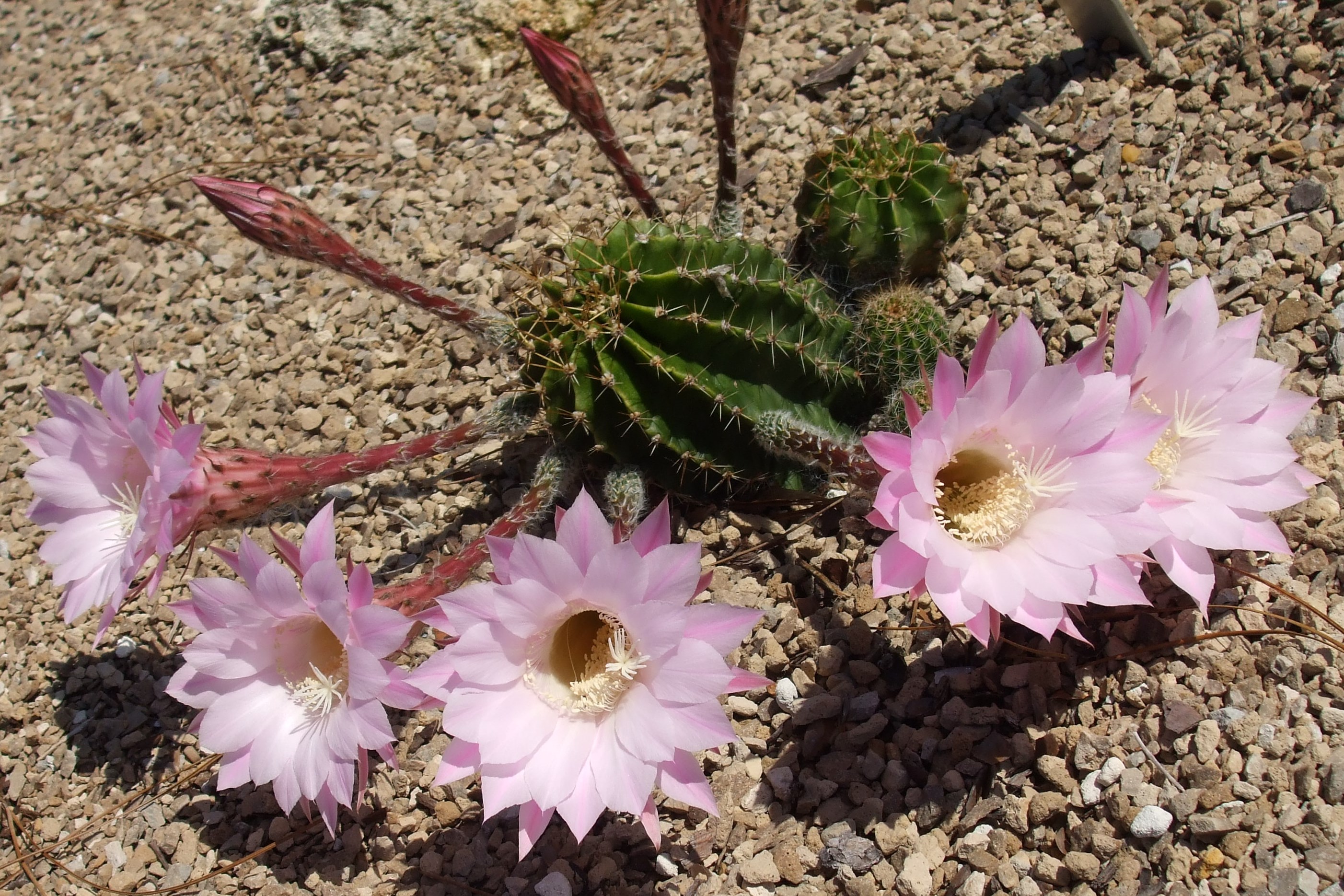
by Gary Knox | May 26, 2015
Summer is here, along with its heat, humidity, drought and stress! One easy way to garden during summer is to use succulents and other drought adapted plants.
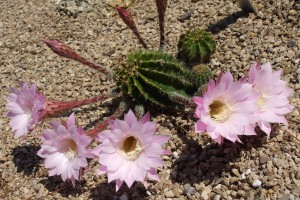
The sea urchin cactus (Echinopsis spp.) produces large, stunning flowers.
Succulents are heat-adapted, water-efficient plants often associated with deserts and dunes. Usually succulents have thick leaves or stems that store water. A cactus is a familiar type of succulent, as are agave, aloe, yucca as well as bromeliads like dyckia. Other dry-adapted plants can retreat into bulbs, rhizomes or other thick plant parts to go dormant until rains resume. A few other strategies used by plants to save water include: waxy or hairy coverings to reduce water loss; extensive root systems to absorb water; and silver- or blue-colored leaves and stems to reflect light and reduce heat.
Succulents’ tough qualities make them well-adapted to the harsh conditions of urban living amid concrete, brick, asphalt and other “hardscapes”. This adaptability translates into low maintenance since they need little or no irrigation, fertilization, pruning or spraying. Do you like container gardens? Succulents are almost the perfect container plant, because they hardly ever need watering!
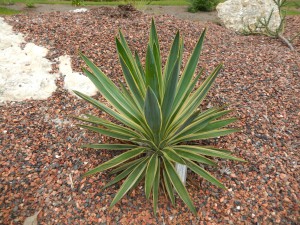
The American century plant (Agave americana) is a large growing succulent with silver-grey leaves.
Above and beyond their toughness, succulents capture our imaginations because they are often dramatic, dangerous and slightly unpredictable. Drama stems from the architectural forms of many thick-leaved plants like agave. Danger arises from the thorns and spines of plants like cactus. Unpredictability results from bulbs and perennials that can quickly explode into flower, and then disappear just as suddenly. Often succulents have outrageous flowers with wild, bold colors and strange shapes!
While many succulents are native to deserts, others are Florida natives where they can be found in coastal dunes or in areas with sandy soils that have little water-holding capacity. For example, many native yuccas are excellent succulents for use in dry gardens or in containers.
For best growth and appearance, most succulents require well-drained soil and full sun (at least 6 hours of direct sunlight per day). Succulents are ideal plants for garden beds near roads, sidewalks, driveways and south-facing walls because they tolerate limited soil moisture, higher soil pH and reflected heat and light usually associated with these areas. On the other hand, try to avoid planting succulents in shady areas, wet areas, low areas that collect water and areas with heavy soils.
Summer gardening is easy with succulents!
For more information:
Agave and Yucca: Tough Plants for Tough Times
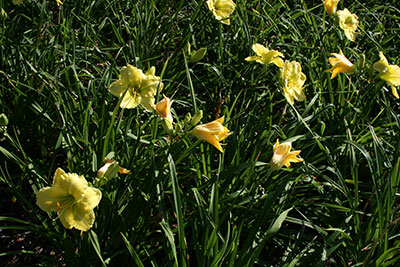
by Roy Carter | May 20, 2014

Daylillies in bloom. Image Credit UF IFAS
The daylily is a popular flowering perennial that adapts well to Florida landscape statewide. Plants are available in a wide variety of growth habits, flower shapes and colors, including yellow, orange, red, pink, and purple, near white and shades and combinations of all of these. Flowering starts in March for early-season bloomers while late-season daylilies won’t bloom until mid-May. Select early and late-season bloomers to extend the flowering season. The typical bloom period is about four to seven weeks, although some varieties bloom even longer.
Daylilies are members of the lily family, in the genus hemerocallis; “Hemero” is Greek for “day” and callis for “beauty”. The flower buds and petals are edible raw, boiled, stir-fried, steamed, or batter and fried. Dried daylily petals, call “golden needles”, are used in numerous Chinese dishes. The modern varieties of daylilies have been developed from native Chinese spices. Early settlers from Europe and Asia brought many of the original species with them to America. During the last 75 years, hybridizers in the United States and England have made great improvement in daylily varieties.
Raising daylilies is fairly simple, but first you have to make sure you’re choosing the right varieties for our area of the state. Daylilies are classified into three groups according to their growth habits – deciduous, semi-evergreen, and evergreen.
As you might expect, the deciduous daylily varieties die back in the winter. They do well in our area. But they don’t receive enough cold weather in South Florida. On the other hand, the evergreen varieties generally grow best in areas with mild winters.
Daylilies may be planted any time of year, but hey usually do best if they’re planted right after flowering. Once they’re established, these lilies need only minimum care.
Proper planting bed preparation is a critical factor in raising daylilies. They are replanted only every five to ten years, so the flower bed needs to have a soil of good quality. The lilies grow best on a well-drained soil with good aeration and good water holding capacity. Sandy soil usually provides the necessary aeration, but they don’t hold water very well. On the other hand, clay soils have good water holding properties, but they don’t provide the aeration lilies need. If your soil is sandy, you need to add two to four inches of peat moss and work it into a depth of sixth to eight inches. If your soil has a great deal of clay in it, you might want to add about an inch of perlite or similar material to increase aeration.
Prior to planting, the flower bed should be fertilized with several inches of a good compost, or 8-8-8 / 10-10-10 mixture, at the rate of two-and-a-half pounds per 100 square feet. An inch or so of water should be applied once or twice a week until the plants are well established. Twice each year, fertilize with the same two-and-a-half pounds of 8-8-8 or 10-10-10 per 100 square feet. Apply the fertilizer evenly, keeping it off the foliage.
Daylilies have a tendency to become crowded, and when this happens, flowers production is reduced. If crowding occurs, you’ll need to divide to the plants by digging them up and severing the Rhizome between the fans of leaves with a sharp knife. Cut the leaves back to within four to six inches of the crown and replant the division.
Daylilies can be planted in a variety of ways to enhance your landscape in informal groupings, in small groups in the space between shrubs or in front of a fence or wall which will serve as a background.
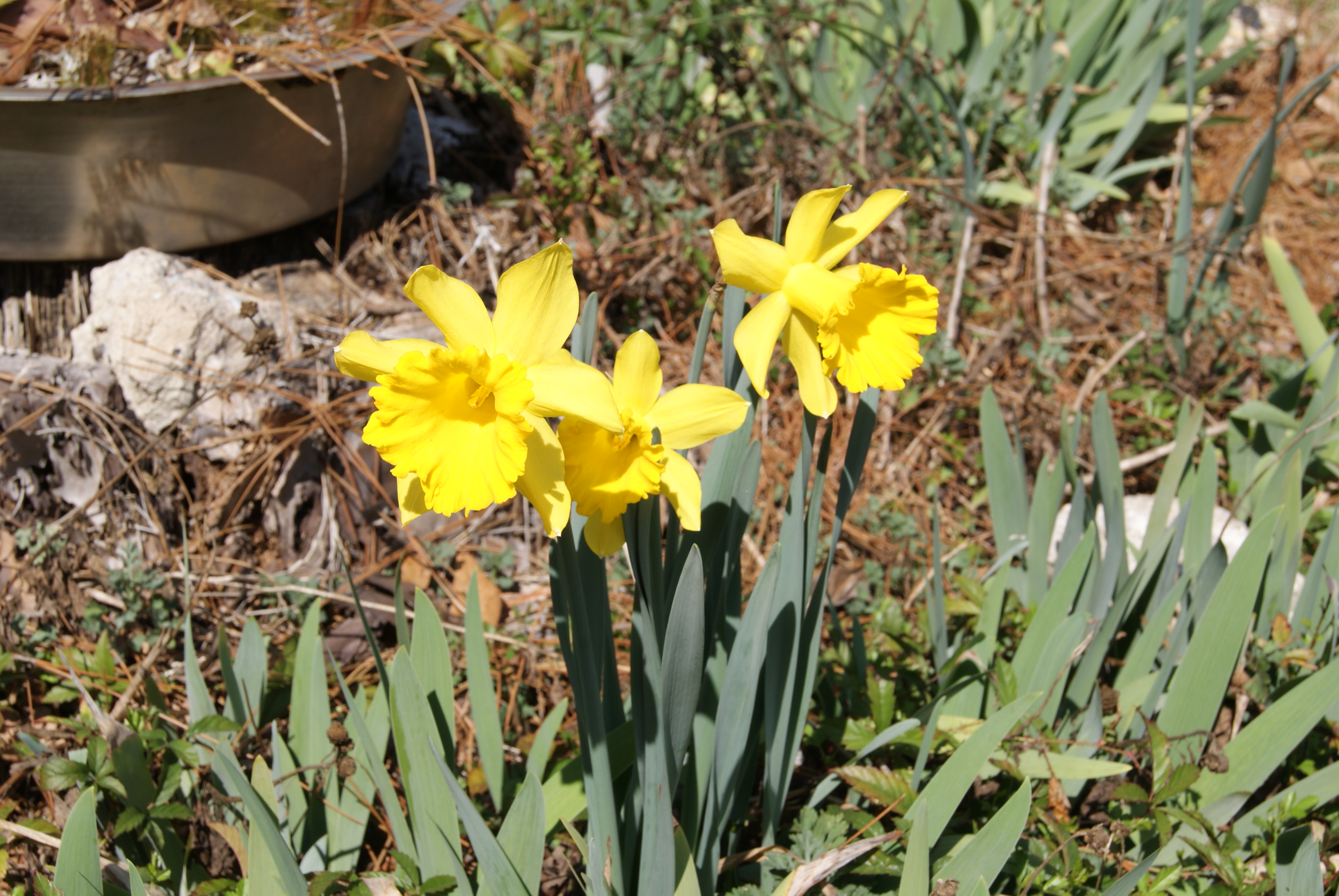
by Sheila Dunning | Mar 4, 2014
Few plants seem to signify the freshness of spring quite as well as daffodils. The name “daffodils” is derived from “addodell” a variant of Asphodel (a plant of the Asphodelus genus.) In historical documents and the common language of 16th century Europe, the term “daffodil” referred specifically to the wild daffodil, Narcissus pseudonarcissus.
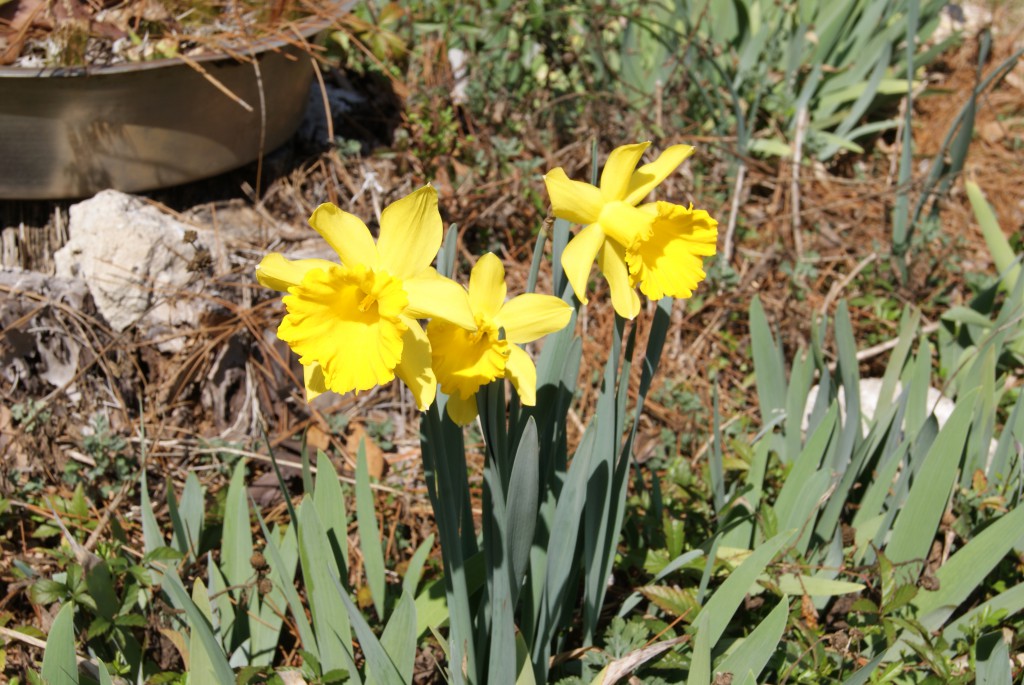
Daffodil in bloom. Image Credit Matthew Orwat
The derivation of the Latin narcissus is unknown. It is frequently linked to the Greek myth of Narcissus, who was rumored to be so obsessed with his own reflection that he died while gazing at himself in a pool of water. From the location of his death sprang the narcissus plant. Another Greek myth finds Persephone, daughter of the goddess Demeter, lured to her doom by the God Hades while picking a narcissus. Therefore the plant is perceived as a symbol of vanity in some Western culture.
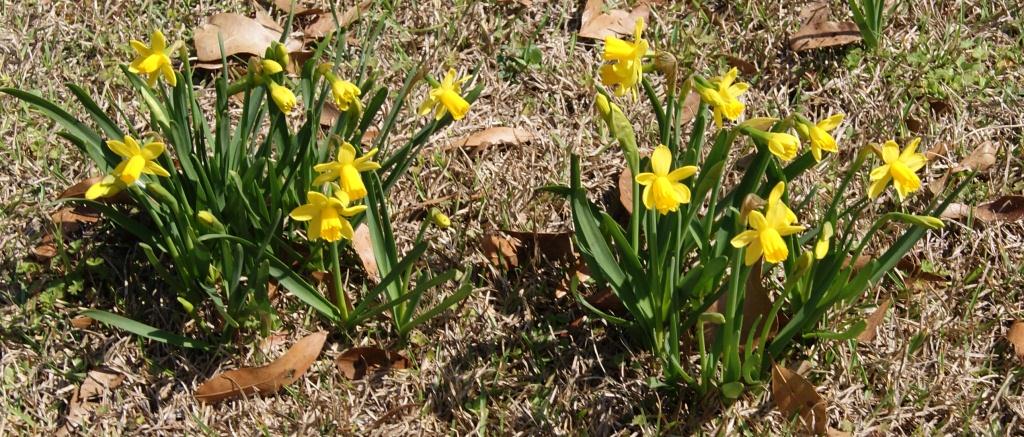
Daffidol cultivar ‘Tete-a-tete’ Image Credit Matthew Orwat
Others attribute the plants’ name to its narcotic properties. One translation of the Greek name is “I grow numb!” All narcissus species contain the alkaloid poison lycorine, mostly in the bulb but also in the leaves. Members of the Amaryllidaceae family contain unique types of alkaloids. They are responsible for the poisonous properties of a number of the species. Of the 200 different chemical compounds found in this plant family, at least 79 of them can be found in narcissus.
Daffodils are a popular potted plant for cut flowers, but also make attractive naturalized groundcovers in gardens and around trees, providing color from the end of winter through late spring. If the narcissus blooms on Chinese New Year, it is said to bring wealth and good fortune throughout the year. The flower color varies from white through pinks and yellows to deep reddish-orange with multiple petal forms. Hundreds of cultivars are available.
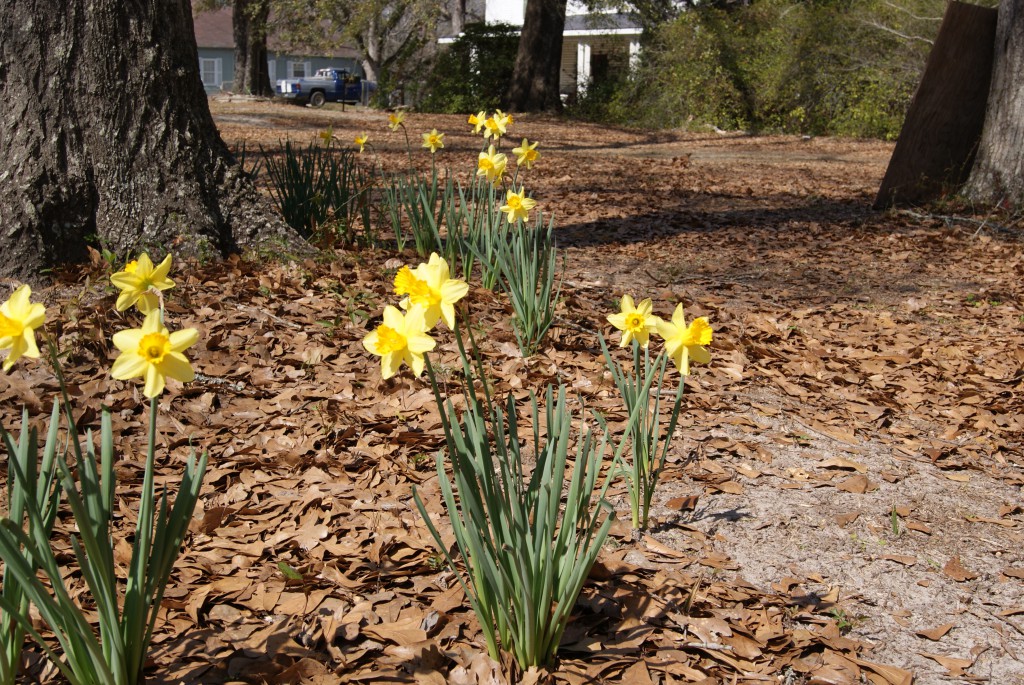
Daffodil bulbs under trees. Image credit Matthew Orwat
Planting dates vary according to geographical location, but bulbs are usually planted in the fall when the soil is cool. Daffodils grow well in full sun or light shade, with the blooms lasting longer when protected from the noon day sun. When selecting a location for planting, it should be noted that the individual flowers will face the sun.
Pre-chilled bulbs should be planted in 6-8” deep holes with a tablespoon of slow release fertilizer added to the soil directly under the bulb and with 4-5” of soil covering the bulb. Watering throughout the winter will be necessary if rains are infrequent. After flowering, the daffodils need to be fertilized and watering should continue. The foliage will naturally turn yellow and die as stored food is restored to the bulb.
Division, transplanting and collection for forcing potted plants can be done after all the foliage has declined. To force Daffodils to bloom at varied times in a container the dried bulbs will need to be stored at a 45° F temperature for 4-6 weeks prior to being placed in the sun to grow.
The bright, cheery Daffodil flowers are beginning to bloom now and will continue as Easter approaches, reminding us that spring really is coming.
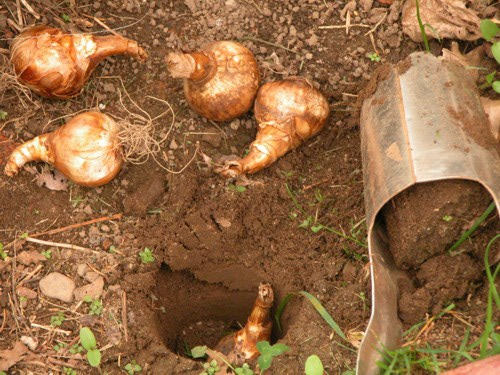
by | Oct 7, 2013
Gardeners may wonder why spring flowering bulbs are a timely topic now when fall is tip-toeing in, but as with most things in horticulture, there is a method to the madness. While many gardeners have become accustomed to running out to the local garden center and buying flats or pots of blooming bedding plants to create “instant gardens”, this last-minute approach simply does not and will not work when spring-flowering bulbs are desired in the landscape. So procrastinators beware! If beautiful beds of daffodils, tulips or Dutch irises are wanted next spring, now is the time to act, not next spring when everyone else’s are blooming.
Spring-flowering bulbs are generally defined as those that bloom here in north Florida between February and April. Information is available dividing these bulbs into categories based on when they bloom in the spring – such as very early, early, mid-season, late and very late. This will allow the garden to be in flower over a longer period during the season.
When buying bulbs, purchase the highest quality stock possible. The quality of the bulb correlates directly to the quality of the blooms. Selecting loose bulbs at a local garden center is like choosing produce at the supermarket. Pick the largest, plumpest bulbs that are firm with no obvious cuts, soft spots or rot. When ordering from a catalog, do it as soon as possible and generally choose the larger sizes when offered.
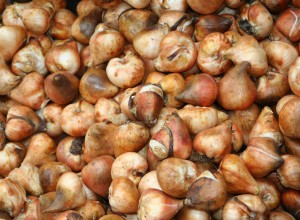
Be picky, look for high quality bulbs.
Choose selections wisely as the flowers of many bulbs do not last an especially long time. For example, while a tulip is a great bulb and an extremely attractive flower, it produces one flower that lasts about seven to ten days and then just like that, it’s done. Ranunculus, on the other hand, can bloom over a four- to six-week period. One thing to expect across the board, however, is the price for color from bulbs is going to be higher than for longer-flowering cool-season bedding plants like pansies and dianthus. If gardening budgets are limited, use spring bulbs more for embellishment and let cool season bedding plants provide the primary floral display.
Obtaining a nice display of spring flowering bulbs depends upon where and how they are planted. Good drainage, part to full sun and moderately fertile soil are all that are needed for bulbs to do well. The average landscape bed generally provides adequate drainage, but avoid low spots that tend to stay moist as this will cause bulbs to rot in a hurry. If drainage is in doubt, plant in raised beds. Choose a spot where there is some shade from the afternoon sun, this allows the flowers to last a little longer, especially if the spring weather turns warm.
It is important to plant bulbs at the proper depth. A rule of thumb is to plant bulbs at a depth equal to twice their height. This far south we generally don’t plant bulbs quite as deep as standard recommendations. Smaller bulbs are planted about 1 or 2 inches deep while larger bulbs are planted about 5 inches deep. Dig individual holes the proper depth, or excavate out, the area to be planted, to the recommended depth and plant all of the bulbs at once.
Once the bulbs are in the ground, plant over them with low growing cool season annuals, such as alyssum, violas, lobelia or pansies. Be careful not to disturb the bulbs. The annuals cover the bare soil and provide color before, during and after the bulbs bloom. Make sure the bulbs will produce blooms that are taller than the annuals, and make sure the colors of the annual flowers contrast with or compliment the flowers of the bulbs in a pleasant way.
Although the proper time to plant most bulbs is October and November, there are a couple of notable exceptions. Tulips and hyacinths will perform much better if they are refrigerated at least six weeks in the vegetable bin of your refrigerator prior to planting (storing longer than six weeks is better) starting now. Store them in paper or net bags (well labeled.) The paper or net allows excellent air circulation that in turn will decrease rot. Avoid storing them near apples and other fruit as these fruit produce a plant hormone called ethylene that can severely alter everything from the time a bulb will bloom to shape, to survival. Plant them in late December or early January when the soil has had a chance to get cold.
Many of the spring bulbs available locally or in catalogs will only bloom reliably for us their first year. Some of the favorites include: tulip, grape hyacinth, crocus, hyacinth, ranunculus, anemone, scilla, freesia, ixia, sparaxis and ornithogalum.
The following are some of the spring bulbs that tend to be reliably long-lived in north Florida and should bloom for several years at least: Narcissus cultivars such as paperwhites, Chinese Sacred Lily, Soleil d’Or, Grand Primo, Cheerfulness, jonquils, Sweetness, Trevethian, Peeping Tom, February Gold, Thalia, Ice Wings, Petrel and larger flowered daffodil cultivars such as Ice Follies, Unsurpassable, Carlton and Fortune.
Other reliable re-blooming bulbs include snowflake (Leucojum aestivum), some flowering onions (Allium neapolitanum, Allium drummondii), ground orchid (Bletilla striata), amaryllis (Hippeastrum species and hybrids), Spanish bluebells (Hyacinthoides hispanica), spring star flower (Ipheion uniflorum), Dutch iris (Iris x hollandica) and Easter lily (Lilium longiflorum).
You can also find an excellent publication written by Dr. Gary Knox on low maintenance bulbs at UF IFAS Extension’s EDIS website.
















